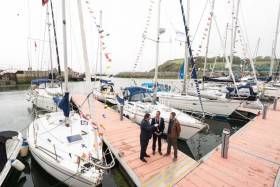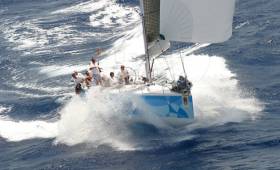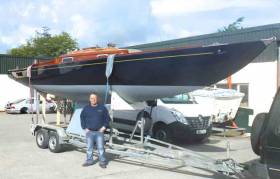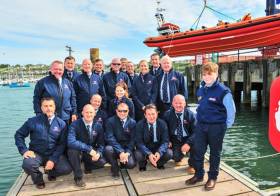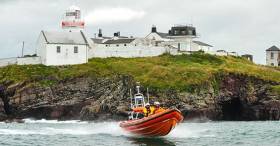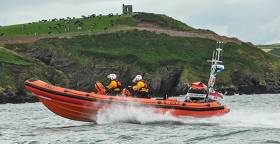Displaying items by tag: Crosshaven
Royal Cork Joins Port Companies To Promote Cork Marine Leisure At Southampton Boat Show
#Tourism - The Port of Cork, Bantry Bay Port Company and the Royal Cork Yacht Club are joining forces to promote marine leisure in Cork at the Southampton Boat Show.
The three organisations are in attendance at Stand J047 from today Friday 15 to Sunday 24 September tasked with promoting their marina facilities to potential visitors.
They will also be targeting the luxury cruisers and motor yacht market to entice further calls to Cork, Crosshaven and Bantry.
In 2009 the Port of Cork implemented the Leisure and Recreation Strategy for Cork Harbour, with the primary focus of the strategy on water-based leisure and recreational activities in and around the harbour.
Speaking about attending the boat show, Sara Mackeown, commercial marketing executive for the Port of Cork, said: “This is great opportunity to showcase Cork as an ideal destination for marine leisure users.
“Our marina facility in the heart of Cork City is unique and having just completed the new Bantry Harbour Marina there is a great connection now between Cork and West Cork. We are delighted to work closely with the Royal Cork Yacht Club, who have huge experience in the field.”
Cork Harbour offers significant potential for further development of the marine recreation sector as an important source of enjoyment and economic gain for the local residents and visitors, and it is anticipated that attending the Southampton Boat Show will help to promote the marine facilities directly to the desired market.
Gavin Deane, general manager of the Royal Cork Yacht Club said: “The Royal Cork Yacht Club are delighted to be collaborating with both the Port of Cork and Bantry Bay Port Company in promoting the region.
“This year we have seen a significant increase in the number of visiting boats to our marina, the majority of whom have travelled from the south coast of the UK.
“We feel that with this growth in visitors, now is the ideal time to showcase everything that Cork has to offer and Southampton Boat Show 2017 is the place to do it.”
Yesterday’s report on Afloat.ie of the major changes shaping up in the ownership structure of the UK/McWilliam Sailmakers business in Crosshaven clearly rings a bell with many in the sailing community at home and abroad. The remarkable response has reinforced the notion that the story of the McWilliam family’s involvement in Irish and international sailing is in many ways a story shared and lived by everyone with a genuine enthusiasm for our sport. W M Nixon reflects on its broader implications.
The past is only really of value when we can relate it to a vibrant present and an interesting future. For sure, history has its own special allure. There may be many different interpretations of what happened and how it happened. But if we ruthlessly pare it down to the most basic timeline, the reasons for argument melt away in face of a short list of inescapable facts. And there’s something very reassuring in a short list of inescapable facts.
But when history is allowed to be more complex, there’s an element of the comfort blanket in immersing ourselves in it. By all means do so if you wish. But life will soon be passing you by if historical obsessions are allowed to dominate your view of the world. Closetted historians – if they emerge from their closed little worlds at all – very quickly discover that other folk are only mildly interested in history as a point of reference against the here and now, and what might be happening tomorrow.
Thus in anticipating what the new team of Barry Hayes, Claire Morgan and Graham Curran will be bringing to Crosshaven at the heart of their new hub of creativity, we’ve been trying to get the proper perspective. In addition to providing their own special skills, they’re able to draw on the shared experience and technologies of their colleagues at almost 50 sail-lofts worldwide.
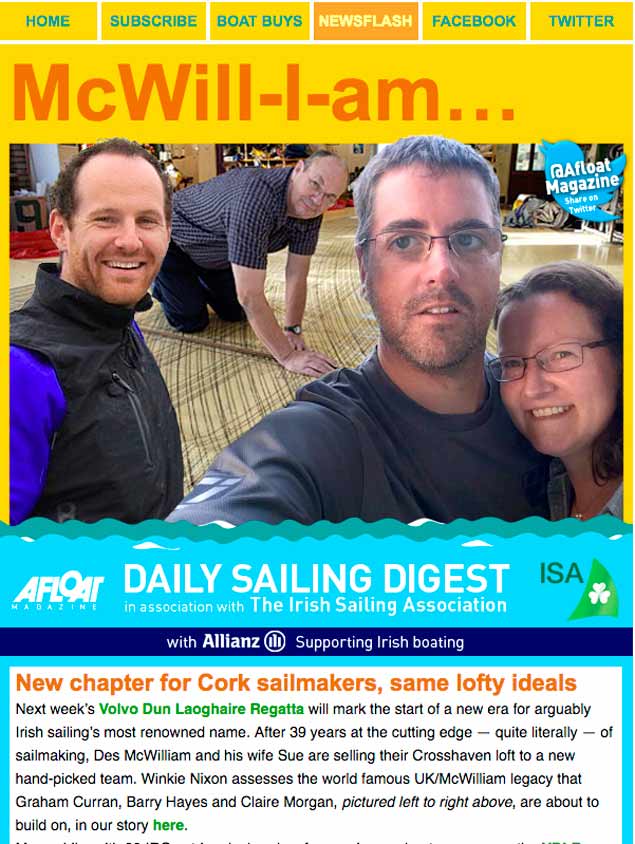 Des McWilliam's retirement and the new team at UK McWilliam in Cork of Barry Hayes, Claire Morgan and Graham Curran featured on Afloat.ie yesterday
Des McWilliam's retirement and the new team at UK McWilliam in Cork of Barry Hayes, Claire Morgan and Graham Curran featured on Afloat.ie yesterday
While Graham is a fast learner who has ascended the rising path in Crosshaven in just three years, and Claire has formidable business and financial skills, it is Barry who is most truly representative of the UK International Sailmakers ethos.
Orginally from Schull, he started in the McWilliam’s Crosshaven loft in 1999 just three years after they’d become associates of UK Sailmakers. Yet within three years he had been invited to join the “mother loft” in New York run by Butch Ulmer, and there he rose to become loft manager.
Then he was recruited from the mother loft to the group’s biggest loft of all, in Hong Kong run by the legendary David Yeung. In his fourteen years there, he has learned everything that David Yeung could teach, and when the great sailmaker finally retired a couple of years ago, it was the young Irishman who took on the role as manager.
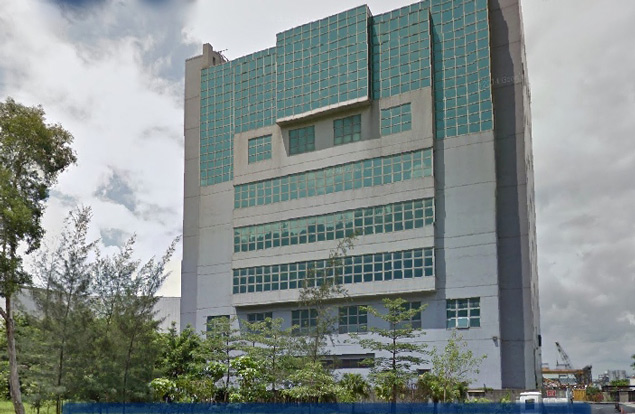 The Hong Kong loft of UK Sailmakers is very typical of the city in which it is located.....
The Hong Kong loft of UK Sailmakers is very typical of the city in which it is located.....
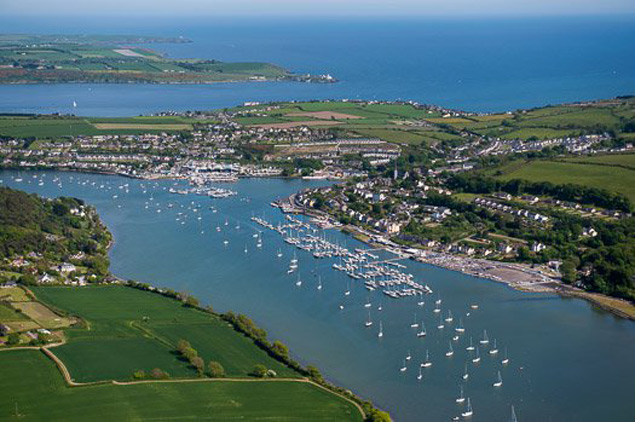 ...which is very different to Crosshaven. Photo: Robert Bateman
...which is very different to Crosshaven. Photo: Robert Bateman
During his time in Hong Kong, Barry Hayes had been at the heart of the loft’s development of titanium sails – among many other projects – so it will be fascinating to see what fresh vistas of development he opens up back in Crosshaven. In other areas of advanced technology, you’d be surprised by the number of specialised Irish outfits – some of them quite small – which are in the forefront of research and development in their own field, so why not Crosshaven and sailmaking?
At the same time, as a sailmaker pure and simple, Barry Hayes has the reputation of being a man who’ll stay up all night beavering away at repairs on your torn mainsail in order that you can sure of getting racing next day, so it’s clear that the loft’s regular everyday customers need not worry that arcane research experiments and developments will distract from the need for traditional sail making and repair services.
And with their considerable combined experience of the McWilliam ethos, and the collegiate outlook of the UK Sailmakers organisation, the new owners will be well aware that the hours will be ridiculous, the miles travelled absurd, and the challenges faced infinite in their variety.
Thus one of my favourite Des McWilliam yarns is of the time he was asked to make sails for the traditional boats of the Achill Yawl type which sail and race on Achill Sound and the nearby waters of Clew Bay. That hero of the Mulranny area, Dr Jerry Crowley, reckoned that a healthy class of Achill yawls regularly sailing in summer would be good for everyone and for community spirit, so he gave every encouragement to getting the fleet into proper action.
 Traditional Achill yawls racing in Achill Sound. With their potentially very powerful rig, when Des McWilliam turned up with new sails, he said it was like putting a Ferrari engine into a Mini
Traditional Achill yawls racing in Achill Sound. With their potentially very powerful rig, when Des McWilliam turned up with new sails, he said it was like putting a Ferrari engine into a Mini
The upshot of it was that as the Celtic Tiger years began to build up a head of steam, every pub along the shores of Achill Sound and anywhere close to the coast nearby found itself sponsoring an Achill Yawl to swell an already considerable privately-owned fleet.
It became increasingly competitive, so inevitably an enquiry was put through to Des McWilliam about making a suit of racing sails, and with one order, others followed. As the Achil yawl sets a powerful lug rig which is as near as you can get to actually being an even more powerful and efficient lateen rig, when Des turned up with a load of max-sized sails at Achill Sound, he asked Jerry Crowley was he aware this would be the equivalent of putting a Ferrari engine into a little old Mini, or even Morris Minor?
This was exactly the impression the owners and skippers wished to make, so the bould Des went off for his first race with the Achill Yawls. They were reaching along in a bunch, and the boat to weather bore down on them until the hulls thumped, and then hauled her wind only the slightest amount.
At the impact Des had called across to the other helmsman: “You can’t do that”. Back came the unanswerable reply: “I just did”. End of conversation.
Within the UK Sailmakers group, Des acquired something of a reputation as an ace specialist in spinnakers, so when America’s Cup legend Dennis Conner out in San Diego asked his local UK Sailmakers loft for a new spinnaker for his personal IRC 50, manager John Bennett passed the order on across America and across the Atlantic to Crosshaven. As Des says, it’s not every day you get an order for a special spinnaker for Dennis Conner, and they gave it the best they could.
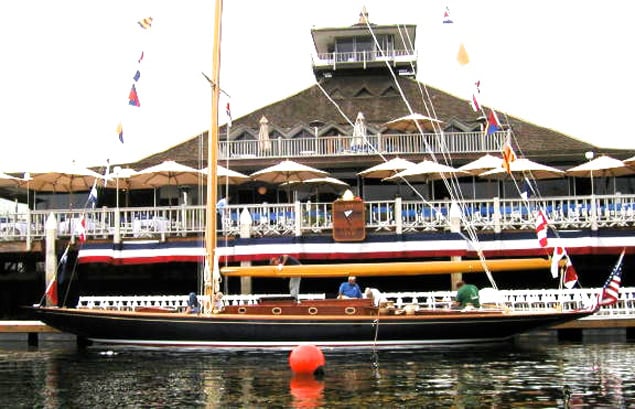 Dennis Conner’s classic Q Class sloop Cotton Blossom II, restored by Johnny Smullen, makes her debut at the San Diego YC. The local UK Sailmakers loft passed along the specific request that Des McWilliam design the spinnakers for the boat
Dennis Conner’s classic Q Class sloop Cotton Blossom II, restored by Johnny Smullen, makes her debut at the San Diego YC. The local UK Sailmakers loft passed along the specific request that Des McWilliam design the spinnakers for the boat
It seems it worked, for when Dun Laoghaire’s own Johnny Smullen restored the classic Q Class Cotton Blossom II in San Diego for Conner, the request came through to Crosshaven for the spinnakers for the re-born boat. It was quite a tricky one says Des, as we had to shape the panels in classic original style.
So the default position in the Crosshaven loft is that the unusual order is the norm. They’re delighted to take on all sorts of challenges, and as founder John McWilliam was originally a fighter jet pilot, in his busiest years with the loft he put his flying skills to good use by having a company plane - a PA 23 Geronimo - for which they didn’t need to hire a pilot to get sails and services as rapidly as possible to customers near and far.
 Dick Newick’s plans for Downtown Flyer, built in a shed in Lisburn, County Antrim
Dick Newick’s plans for Downtown Flyer, built in a shed in Lisburn, County Antrim
However, even by McWilliam standards, the liberation of the trimaran Downtown Flyer from a hidden berth in France was in a league of its own. Downtown Flyer was a 38ft Newick tri built by Brian Law and Dickie Gomes in a shed in Lisburn in Northern Ireland for the 1982 Round Britain and Ireland two-handed race, in which they did mighty well. In fact, they did mighty well in just about every event they entered, and put in such a spectacular showing at the Speed Week in La Trinite in France that when, after a couple of years of very intensive campaigning, they decided to sell, Downtown Flyer was quickly snapped up by a young French skipper who very promptly paid 50% of the purchase price.
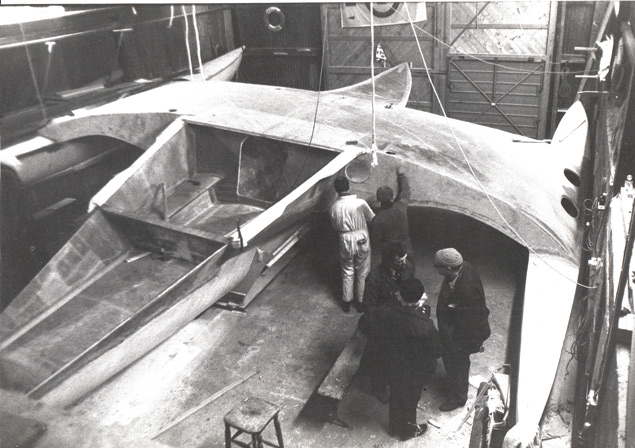 Downtown Flyer under construction in 1982. Her beam was nearly as great as her overall length. Photo W M Nixon
Downtown Flyer under construction in 1982. Her beam was nearly as great as her overall length. Photo W M Nixon
He was so keen to be in place for the next big race in France that the two lads allowed him and his crew to sail the boat away with the promise that the rest of the money would be paid the following week. Weeks passed. Months passed. But money came there none. Recourse to lawyers failed too. They were getting nowhere. But as Johnny McWilliam had made sails for them for a number of craft, he was aware of their predicament, and enthusiastically joined in a project to re-possess the boat.
She was berthed in the heart of a sort of Navy yard in Lorient. But the guys worked out that if they could fly in Johnny’s plane to a little local airfield and implement the plan once night came on, it might just be managed. So they flew down to Brittany and after helping Johnny re-fuel for his fight home by using a local garage and portable tanks so as not to attract official attention, the Liberation Team got to the boat without being noticed as night drew on.
 The McWilliam Sailmakers’ PA 23 Geronimo was useful for many tasks, not least a surreal boat liberation
The McWilliam Sailmakers’ PA 23 Geronimo was useful for many tasks, not least a surreal boat liberation
They got away by paddling Downtown Flyer as quietly as possible the length of Lorient Harbour, where they sped away once sail was set. But instead of heading straight for Ireland as any search ship would have expected, they sailed due west into the middle of the Bay of Biscay before turning north for a safe return.
They kept the boat for sale to another purchaser, and in due course the French skipper was given his deposit back. But to receive it, he had to take the Roscoff ferry to Cork to meet the Downtown duo, as they had to return extra equipment that had somehow been added to the boat despite the potential buyer’s supposed penniless state.
In his retirement Johnny has devoted himself to glider flying a a very advanced level, while Des looks forward to getting in some sailing just for fun - he much enjoyed a recent outing with the new sails he made for Guapa, the Bill Trafford-reworked Etchells 22.
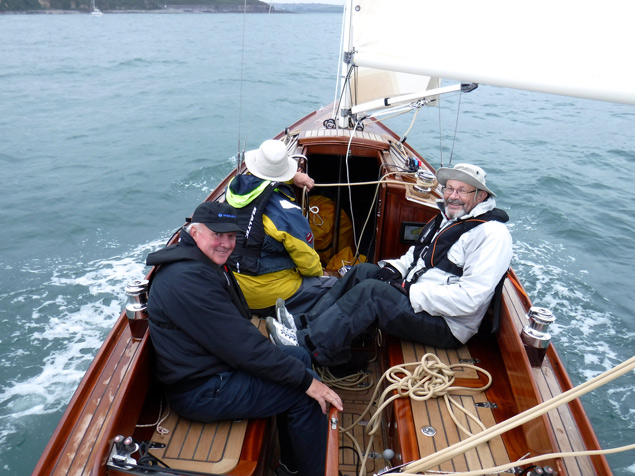 Making a classic suit of sails for the uniquely re-configured Etchells 22 Guapa a month ago was a special pleasure for Des (right) But there’s no doubt that Des’s passion for vintage and classic cars can now come centre stage. It started with a hectic youthful career with vintage motorbikes, but these days he has a sort of compromise with a 1934 Morgan F4 three-wheeler in which he and his wife Sue can take on hill climbs and other vintage car trials with eccentric style.
Making a classic suit of sails for the uniquely re-configured Etchells 22 Guapa a month ago was a special pleasure for Des (right) But there’s no doubt that Des’s passion for vintage and classic cars can now come centre stage. It started with a hectic youthful career with vintage motorbikes, but these days he has a sort of compromise with a 1934 Morgan F4 three-wheeler in which he and his wife Sue can take on hill climbs and other vintage car trials with eccentric style.
 Des and Sue McWilliam in their 1934 vintage Morgan three-wheeler
Des and Sue McWilliam in their 1934 vintage Morgan three-wheeler
In fact, in this little machine, there’s little enough for their comfort when they’re undertaking challenges like the Tim Healy Pass which snakes over the mountains between Bantry Bay and the Kenmare River, but they’re seen doing it with style in this short vid from Easter last year:
The virtue of the Tim Healy event is that afterwards everyone winds their way down from the mountain to the comfort of that noted cruising enthusiasts’ pub, Teddy’s at Kilmakilloge, and the event concludes with a dinner where the attendance on this occasion included nine former Circuit of Ireland winners. But the real winner of the evening was Sue, as she received the Trophy for the Bravest Participant – as that little vid reveals, it was well earned.
Unfortunately, a couple of weeks later while on their way to another vintage car trial, they were the victims of an absent-minded tourist who forgot that we drive on the left in Ireland, and in a serious smash Sue was badly injured. But she’s on the mend, and is looking forward to sharing Des’s new availability for their many interests and family gatherings.
Meanwhile at the Crosshaven loft, the new order of management is already moving into place, and next week will see the UK Sailmakers Crosshaven team present in full strength at the Volvo Dun Laoghaire Regatta. These are very interesting times in sail-making, and the hothouse of competition that Dublin Bay will provide next week is just what’s needed to get fresh ideas to take shape.
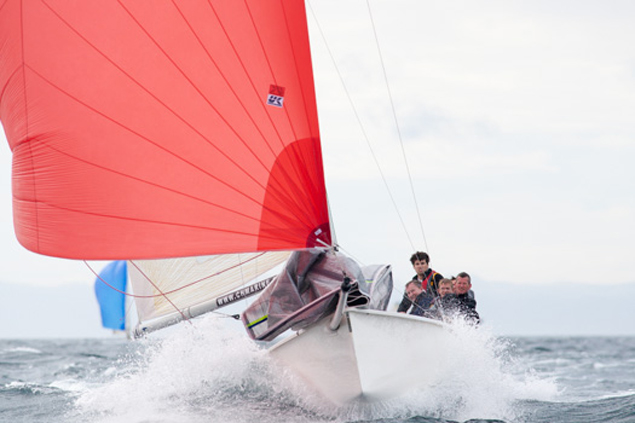 This is what we do. One of the O’Leary Clan’s 1720s burning it up under a new UK Sailmakers asymmetrical kite
This is what we do. One of the O’Leary Clan’s 1720s burning it up under a new UK Sailmakers asymmetrical kite
Traditional Boats in Crosshaven This Weekend
Preserving traditional boats is very important, using them even more so and racing them a sight to behold writes Tom MacSweeney. All can be seen this weekend at Crosshaven in Cork Harbour where vintage boats of all types, shapes and sizes will gather for the annual Crosshaven Traditional Sail.
It begins this evening with the official opening at the Oar Bar in the village at 7.30 p.m. Boats will be at the Hugh Coveney Pier where Skippers will be briefed at 1230 on Saturday about the first race, scheduled to start at 2 pm off ‘the Grassy,’ traditional sail race starting point for generations of sailors.
There is another race scheduled for Sunday, again at 2 p.m., with a Parade of Sail afterwards.
What I particularly like about the traditional boat people is their ‘relaxed’ approach to sailing. They make it a strong social occasion when they gather. They are a magnificent sight racing in the harbour, boats of many kinds, and sails of several colours.
There will also be a ‘Pirates Trail’ and a ‘Seafood Trail’ to be followed.
“Our purpose is to make sailing enjoyable and show how valuable it is for our maritime heritage and culture not only to preserve the traditional boats, but to keep them in use. That’s the purpose of a boat, to use and enjoy it,” the organisers say. There will be prizes for the racing, for the best dressed boat, best dressed crew, oldest and youngest crew and the boat which travels further to reach Crosshaven.
Etchells 22 Super De Luxe Heads For Crosshaven
As Johnny Smullen, boatbuilder to America’s Cup legend Dennis Conner has put it, the transformation job on a tired old Etchells 22 is simply amazing writes W M Nixon
The well-worn white hull of a standard Etchells 22 went into Bill Trafford's shed near Skenakilla Crossroads in March last year. And this week, the gorgeous dark blue cruising sloop Guapa (it’s Spanish for beautiful) emerged. See our April progress report here.
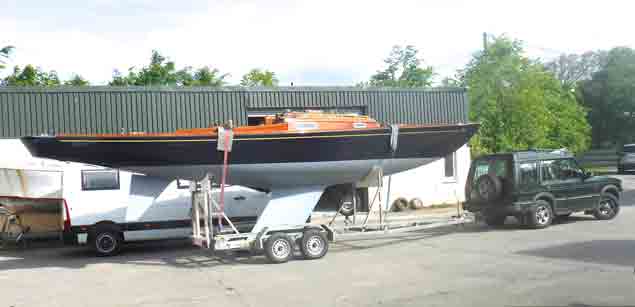 Elegance is the hallmark
Elegance is the hallmark
Next Wednesday she’ll be arriving in Crosshaven for her mast to be stepped and new sails fitted from Des McWilliam. But the boat is so utterly transformed, with judiciously-raised topsides and an extremely elegant Scandinavian-style coachroof and comfortable accommodation within, that Bill naturally wondered if his calculations as to the new location of the waterline were accurate.
Indeed, like every boat-transformer, he wondered if she’d float. So rather than give her a totally-untested debut at Crosshaven, Guapa was quietly towed up the road to Doneraile, where the equipe stopped outside the Townhouse Tea Room for some sustenance, as Bill’s wife works there (and it’s Georgina Campbell-recommended).
 Quick sustenance stop as viewed from the Townhouse tea Room in Donraile
Quick sustenance stop as viewed from the Townhouse tea Room in Donraile
Then it was on up the road to Adare and down to Askeaton off the Shannon Estuary, where Cyril Ryan at his boatyard had the crane ready, and Guapa had her first splash in complete privacy. No leaks. And she floated perfectly on her marks. All being well, next Wednesday in Crosshaven, you’re in for a treat.
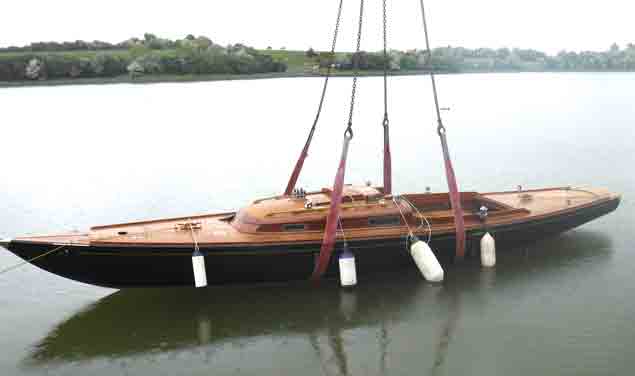 At Askeaton, Guapa floats to her marks
At Askeaton, Guapa floats to her marks
Red Bay Lifeboat Rescues Three Off Glenarm
#RNLI - Red Bay RNLI’s lifeboat was launched yesterday afternoon (Sunday 5 February) to locate and rescue three people on board a 13ft boat off Glenarm Bay.
The lifeboat crew located the vessel, which had suffered engine failure, three miles east of Glenarm Marina.
Two people on board the boat were transferred to the lifeboat before the vessel was taken in tow to Glenarm.
The three men were on a fishing trip and contacted Belfast Coastguard by mobile phone to raise the alarm. Sea conditions were calm with freezing temperatures.
Around the same time, the volunteer lifeboat crew at Crosshaven RNLI in Cork Harbour launched to assist a grounded yacht.
On arrival, the lifeboat transferred a crew member to the yacht and made good a towline. Before the tow commenced the yacht's integrity was checked.
After successfully towing the vessel into deep water, another check for leaks was made before the yacht and its crew were happy to make their own way to East Ferry.
Crosshaven Boatyard Set For Sale As Going Concern
#CorkHarbour - Doyle Shipping Group will concentrate its core stevedoring business in Dublin, Cork and elsewhere in Ireland as it prepares to offer Crosshaven Boatyard for sale as a going concern this year.
That’s according to yard manager Matt Foley, who confirmed plans to the Irish Examiner upon speculation that the established Cork Harbour fixture would go on the market in the coming months, potentially asking in the region of €4-5 million.
Though the yard left the boatbuilding trade many years ago — with a legacy that includes Denis Doyle’s Moonduster yachts, Sir Francis Chichester’s Gypsy Moth V and Tim Severin’s St Brendan replica — it continues as a storage and servicing facility, employing seven.
The Irish Examiner has much more on the story HERE.
Two New RNLI Inshore Atlantic 85 Class Lifeboats Officially Named in County Cork
There were double celebrations for the RNLI in County Cork this weekend with two new lifeboats officially named and blessed in Youghal and Crosshaven.
At a special ceremony held on Saturday, Youghal RNLI officially named its new Atlantic 85 class lifeboat, Gordon and Phil, while today (Sunday 11 September) Crosshaven RNLI named its new lifeboat John and Janet.
The honour of naming Youghal’s new lifeboat went to eight-year-old Izzy O’Connell, and Albert Muckley, Deputy Launching Authority.
Izzy who was diagnosed with a brain tumour in 2014 is a friend of the station. The lifeboat crew who have admired Izzy’s determination and courage, wanted her to play a special part in their day.
Ahead of the naming, Catherine Fitzgerald Hourigan, who has held several fundraising events in aid of the station, was invited to represent the late donor Gwenda Bull, and hand the new lifeboat to the RNLI.
Peter CrowIey, RNLI Vice President, accepted the lifeboat on behalf of the RNLI before handing her over into the care of Youghal Lifeboat Station. The lifeboat was then accepted on behalf of the crew by Lifeboat Operations Manager Fergus Hopkins.
Gwenda Bull, who lived in Brighton, East Sussex, admired the work of the RNLI as did her family. She funded various equipment for Shoreham lifeboat station and went to see the new Tamar lifeboat arrive at Shoreham back in December 2010.
Miss Bull also kindly funded the purchase of a new inshore lifeboat, to be named Gordon and Phil in memory of her parents. She was happy for the lifeboat to go on station wherever it would be of most benefit around the coast, so her funds were used to purchase the new B class lifeboat in Youghal.
Mr Hopkins remembered and thanked Miss Bull, adding that her generosity had given Youghal RNLI a lifesaver.
‘When the crew arrive here,’ he said, ‘and get kitted up, and head out to sea, we’ll have peace of mind. Because this lifeboat will help to keep them safe, as they save others’.
Pat O’Keefe, fundraising committee member recounted a historical call out before the Very Reverend David Herlihy, Parish Priest, the Very Reverend Alan Marley and the Reverend Tim Kingston lead the Service of dedication. Izzy and Albert then officially named the lifeboat Gordon and Phil, while pouring a bottle of champagne over the lifeboat which then put to sea.
The new lifeboat replaced Patricia Jennings which during her 13 years in Youghal launched 175 times with its crews saving nine lives and rescuing 233 people.
The celebrations moved to Crosshaven this afternoon where the honour of naming the lifeboat went to young Paddy Crowley, son of the late Con, who was a helm at the station prior to his sudden death last year.
Afloat journalist Tom MacSweeney was invited to represent the anonymous donor of the new lifeboat John and Janet and hand her over to the RNLI.
Speaking at the ceremony, Mr MacSweeney said: ‘On this occasion, the incredibly generous donor of this new lifeboat has decided to remain anonymous. We can all agree this is an incredible act of kindness and so I offer my sincere thanks to the donor and I know this lifeboat will be a much loved asset to the community of Crosshaven.’
Clayton Love, RNLI Vice President, accepted the lifeboat on behalf of the RNLI and handed her into the care of the Crosshaven lifeboat crew. It was Mr Love’s family who kindly donated the station’s former lifeboat, Miss Betty.
On accepting the lifeboat, Patsy Fegan, Lifeboat Operations Manager said: ‘People from all walks of life represent our volunteers who without a thought at any time day or night will drop everything when their pager goes off and come down to the station. When the crew arrive here, they prepare themselves and the boat, don their suits and go to sea to save the lives of others. This new Atlantic 85 class lifeboat will help to keep our volunteer crew safe, as they rescue others.’
The Very Reverend Fr Pat Stevenson and Reverend Isobel Jackson lead the Service of Dedication before Paddy Crowley, son of the late Con, officially named the lifeboat John and Janet.
Last year, Crosshaven RNLI launched 42 times and rescued 50 people. The new lifeboat replaces Miss Betty, the station’s first permanent lifeboat, which was on service in Crosshaven since the station was formally established 14 years ago.
The new state of the art Atlantic 85 lifeboat was introduced into the RNLI fleet in 2005. The lifeboat is 8.4 metres in length and weighs 1.8 tonnes. Improvements on its predecessor include a faster top speed of 35 knots, radar, provision for a fourth crew member and more space for survivors.
Fast, manoeuvrable and reliable, the B class operates in rough weather conditions, capable in daylight up to force seven and at night, to force six winds.
The new lifeboat, an Atlantic 85 is the latest version of the B class.
Crosshaven RNLI New Inshore Lifeboat To Be Named 'John and Janet'
A new Atlantic 85 lifeboat for Crosshaven RNLI is to be officially named John and Janet during a ceremony at the Cork lifeboat station at 2pm on Sunday 11 September.
The lifeboat which went on service in June this year was funded by an anonymous donor. Afloat.ie's Tom MacSweeney will represent the donor at the naming ceremony and service of dedication and will officially hand the lifeboat into the care of the RNLI.
The lifeboat will be named by Paddy Crowley, son of the late Con, a long serving and much loved helm at Crosshaven RNLI who died suddenly last year.
Last year, Crosshaven RNLI launched 42 times and rescued 50 people. The new lifeboat replaces Miss Betty, the station’s first permanent lifeboat, which was on service in Crosshaven since the station was formally established 14 years ago.
Speaking ahead of next week’s event, Patsy Fegan, Crosshaven RNLI Lifeboat Operations Manager said: ‘The naming ceremony and service of dedication is a very special occasion for our lifeboat station and we are grateful to the anonymous donor who funded our new lifeboat. Since the lifeboat went on service in June, it has launched 17 times and rescued 34 people.’
Fast, manoeuvrable and reliable, the B class operates in rough weather conditions, capable in daylight up to force seven and at night, to force six winds.
The new lifeboat, an Atlantic 85 is the latest version of the B class, introduced into the fleet in 2005. She is powered by two 115horsepower engines and has a stronger hull and greater top speed than her predecessor. The added radar allows the crew to operate more effectively in poor visibility and she also has VHF direction-finding equipment.
The vessel also has a manually operated self-righting mechanism which combined with inversion-proofed engines keep the lifeboat operational even after capsize. The lifeboat can also be beached in an emergency without causing damage to its engines or steering gear.
The Atlantic 85 carries a full suite of communication and electronic navigation aids, as well as a searchlight, night-vision equipment and flares for night-time operations.
The RNLI first established Queenstown Lifeboat Station in 1866, following several wrecks with loss of life off Cork Harbour. However, the first record of a lifeboat in Cork Harbour was as far back as 1825, one year after the founding of the Institution.
Since the closure of Queenstown in 1920, many attempts were made to site a lifeboat in the harbour.
Based on the level of activity in the area, the availability of crew and temporary facilities, a decision was taken to place an Atlantic 21 on evaluation for 12 months in 2000 before the RNLI declared the station a permanent facility in 2001.
Miss Betty, the station’s first permanent lifeboat arrived in 2002 where she remained on service until June this year.
The RNLI is a charity which relies on voluntary contributions and legacies.
Crosshaven RNLI Lifeboat crew responded to a request from Valentia Coast Guard this evening to a person seen being held onto the side of a moored boat in the Channel at East Ferry.
The Crosshaven volunteer crew happened to be near Roches Point on exercise when the emergency call came through and immediately made best speed to the area arriving some 15 minutes later at 20.45. The crew located the casualty and recovered him to the lifeboat.
It appears the sailor had the mishap while transferring to a punt. The other person required no assistance.
With obvious signs of hypothermia and limb injuries after spending 20/25 minutes in the water, the lifeboat crew administered First Aid and headed for Cobh and a rendevous with the Emergency Ambulance. The casualty was handed into the care of the paramedics before returning to station at 21.50.
Crosshaven RNLI Launch to Supermarket Dinghy Blown Out to Sea
Crosshaven lifeboat was launched this afternoon after a member of the public alerted the Coast Guard to an inflatable Dinghy with thre persons on board being blown out to sea.
The lifeboat launched at 14.52 and made their way to Ringabella Bay arriving on scene at 3.10pm. No sighting of the dinghy initially was made, but the crew noticed a Supermarket type inflatable dinghy on the shore at Ringabella beach. A crew member swam ashore and talked to the owners who confirmed they were the 3 people that had left Fountainstown. As they were now ashore and safe all units were stood down.
The occupants were wearing swim gear apart from one who had a wetsuit and a bouyancy aid. The wind offshore was blowing force 5 to 6 although calmer within the bay. Crosshaven Coast Guard imparted safety information to the people involved.
Commenting on the service call, Patsy Fegan, Lifeboat Operations manager said "The use of inflatables and lilo's should only be used in the confines of a swimming pool. Luckily these people came to no harm, but with a force 5 wind they could have drifted well offshore”
As well as Crosshaven Lifeboat, other agencies involved were Rescue 117 helicopter from Waterford, The Naval vessel, LE Niamh which acted as a Radio Relay to the Coast Guard and the Crosshaven Coast Guard boat.




























